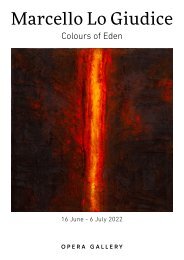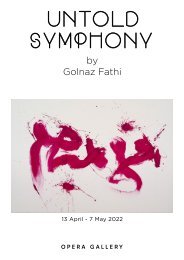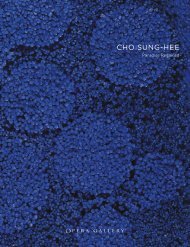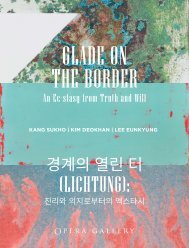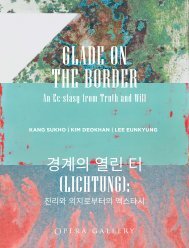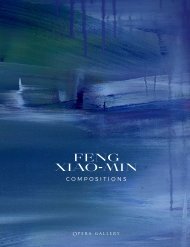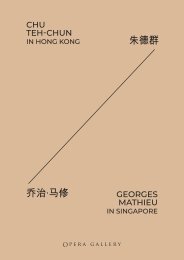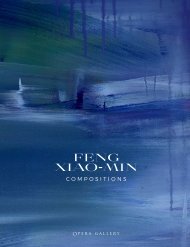BlackWhite catalogue 26 Feb[3].compressed
Create successful ePaper yourself
Turn your PDF publications into a flip-book with our unique Google optimized e-Paper software.
BLACK & WHITE
BLACK & WHITE<br />
Opera Gallery Beirut
preface<br />
Be it aesthetic, symbolic or religious, the pairing and contrast of black and white, is omnipresent in<br />
what we see in our daily life and experience symbolically in our beliefs. The duality of the yin and the<br />
yang of black and white reflects the oppositional forces of existence in harmony.<br />
Naturally, artist themselves have also evolved with this dichotomy of colours. Since the<br />
Renaissance, painters have employed grisaille to draft an artwork or to imitate metals and stone.<br />
Many Neoclassical sculptors have forfeited polychromy found on classical or medieval works for the<br />
raw material of marble or stone, the state in which these works were found during archaeological<br />
excavations. Etching and calligraphy have left their mark on the evolution of arts too and with the<br />
onset of photography, black and white prints became valuable material for artists before emerging<br />
as works of art in their own right which then progressed in early video.<br />
The artists presented in Black & White carry on this long and fundamental tradition. Soulages’<br />
‘Outrenoir’ (beyond black) makes light appear from matter, whereas Lombardi’s photographs use a<br />
clever play of contrast to evoke both intimacy and sensuality. Works of Alfred Haberpointner and<br />
Anselm Reyle play on variations of volume to resonate and fulfil astounding formalistic effects.<br />
Bahk Seon Ghi’s installations explore suspension in space and material (carbon) to interrogate our<br />
relations to time, to space and to nature. Yasmina Alaoui too uses the rawness of her materials, to<br />
question the fragility and changing nature of her cultural heritage. Finally, we observe the universal<br />
aspect of black and white expressed perfectly by the young Thai artist Sittiphon Lochaisong (aka<br />
BOMB) who delicately disperses white pigment on a black canvas, depicting an ideal universe.<br />
This Black & White selection is an opportunity to reunite at Opera Gallery Beirut with a diverse<br />
group of artists and techniques woven together by the theme of the exhibition. We hope that it will<br />
enchant you as much as it did us to put it together.<br />
Salwa Chalhoub<br />
Director<br />
Opera Gallery Beirut<br />
Gilles Dyan<br />
Founder & Chairman<br />
Opera Gallery Group<br />
''This secret light comes from black.’’<br />
Pierre Soulages<br />
''White acts on our soul like silence, the void before the beginning.’’<br />
Wassily Kandinsky<br />
4
CHAE SUNG-PIL (b. 1972)<br />
Terre anonyme 141119, 2014<br />
Soil, natural pigment and India ink on canvas<br />
116 x 89 cm I 45.7 x 35 in<br />
Chae Sung-Pil is a South Korean artist currently residing in France.<br />
Combining the philosophy and techniques of traditional oriental<br />
aesthetics traditions together with a 'Quest for new ideas' expressed<br />
in Western art, Chae Sung-Pil is quickly becoming one of Korea’s<br />
most established and prominent artists. His soil palette, collected<br />
from various trips around the world and then filtered, diluted with<br />
water and mixed with glue, creates an abstract texture on canvas<br />
reminiscent of texture of the earth itself. The soil is specially<br />
prepared on mulberry paper and often mixed with Chinese ink and<br />
powdered silver and gold dust. The organic mixture is then applied<br />
onto the canvas with a large brush or brooklets of water, which<br />
interact with the soil through slight tilts in the angle of the canvas.<br />
Chae Sung-Pil is a doctoral candidate in Plastic Arts in the Université<br />
de Paris. He holds an MA and BA from Seoul National University and<br />
a second Masters from Université de Rennes II. He has held solo<br />
exhibitions throughout France, South Korea and China and took part<br />
in the 2014 London Art Fair, 2012 Art Basel and 2011 London Art Fair.<br />
5
YASMINA ALAOUI (b. 1977)<br />
White Square #3, 2017<br />
Acrylic paint, salt, plaster, minerals and gravel on wood<br />
158 x 158 cm I 62.2 x 62.2 in<br />
Yasmina Alaoui is of French and Moroccan descent. She started<br />
making art at the age of seven. To further pursue her passion and<br />
talent in art, Yasmina Alaoui studied Fine Arts at the Carrousel du<br />
Louvre in Paris and graduated with a B.A. in Sculpture from the<br />
College of William and Mary.<br />
Immersed in a bicultural environment, Yasmina Alaoui asserted her<br />
refusal of every stereotypes and found inspiration in a wide range of<br />
artistic movements, allowing herself to incorporate into her art any<br />
subject that gets her attention. The underlying themes behind her<br />
works directly deal with her experiences of multicultural upbringing<br />
and aim at bridging extremes and embracing opposites: secular<br />
and holy; classical and contemporary; order and chaos; repulsion<br />
and attraction. She is known to create complex and intricate<br />
visual works, using a variety of techniques that she combines in an<br />
authentic manner.<br />
Yasmina Alaoui's professional career as an artist truly began with<br />
the collaboration she made with the photographer Marco Guerra and<br />
from which resulted the 1001 Dreams series in 2003. Since then, she<br />
has diversified her projects, stating that it is her love for different<br />
media that led her to use all of them, constantly shifting between<br />
sculpture, painting, drawing, fashion and jewellery designing, film<br />
making and even music composing.<br />
7<br />
Recently, she started exploring new artistic horizons, notably<br />
producing large-scall works (panel paintings, triptychs and square<br />
formats) with abstract compositions that evoke landscapes<br />
observed from the sky. Yasmina Alaoui currently lives and works<br />
in New York and Marrakesh. Her works have been collected and<br />
exhibited internationally since 2003.
YASMINA ALAOUI (b. 1977)<br />
Silver Rectangle #1, 2017<br />
Acrylic paint, pigments, salt and gravel on wood<br />
176 x 230 cm I 69.3 x 90.6 in<br />
10
SITTIPHON LOCHAINSONG aka BOMB (b. 1991)<br />
Full, 2017<br />
Tempera powder on canvas<br />
150 x 180 cm I 59.1 x 70.9 in<br />
Clear and vague points are joined and assembled. Dots, figures and<br />
symbols meet with sensation and imagination. The delicate and the<br />
rough reflect a complicated mind which embeds both extremes: good<br />
and evil, birth and death. These works reflect moral principles, which<br />
motivate me to reach a clearer state of mind: The consciousness<br />
perceives the unstoppable movement of nature abstracted, causing<br />
the mind to concentrate, understand the truth, and realise natural<br />
balance. Such experiences raise our consciousness higher and lift us<br />
up to next level of morality. Each work is a universe, which we all have<br />
built forever in one's mind: the idealistic Universe.<br />
Sittiphon Lochaisong aka BOMB, 2017<br />
11<br />
12
UMBERTO MARIANI (b. 1936)<br />
Senza titolo, 2014<br />
Vinyl and sand on lead sheet<br />
90 x 120 cm I 35.4 x 47.2 in.<br />
Umberto Mariani was born in Milan, Italy, in 1936. His<br />
family home was used as a refuge for Jews persecuted<br />
during World War II. The war left lasting impressions<br />
on the artist, particularly the last months of 1945, and<br />
his works have been in continual evolution ever since.<br />
Mariani's first works are marked by the presence of bright<br />
colors dominating the canvas. His recent works show a<br />
complex use of shadows using white and black drapery, his<br />
signature alphabet letters and embossed symbols, all signs<br />
of the dramatic, semantic ambiguity of a language that is<br />
not always decipherable. Drawing much of his inspiration<br />
from the classical Greek statues that he saw growing up<br />
in Italy, Mariani's fascination with the balance between<br />
fragility of form and one strength of material is evident in<br />
these highly textured pieces. The method of drapery on the<br />
canvas constitutes intricate illusions of light and shadow,<br />
at once concealing and revealing what lies beneath.<br />
13<br />
14
PINO MANOS (b. 1930)<br />
Spazio estroflesso grafite argentea, 2011<br />
Mixed media on canvas<br />
100 x 100 cm I 39.4 x 39.4 in<br />
Pino Manos was born in Sassari, Italy, in 1930. He moved<br />
to Milan in 1951 to attend the Accademia delle Belle<br />
Arti di Brera, along with Enrico Castellani and Vincenzo<br />
Agnetti. A friend of Roberto Crippa, Gianni Dova, Marino<br />
Marini, Augustino Bonalumi and especially of Lucio<br />
Fontana, he adhered to the Spatialism movement. In 1962<br />
he was called to London, along with thirty of the most<br />
eminent artists in Europe to be part of the Manifesto<br />
‘Europe 1962’ Painting and Sculpture organised by the<br />
New Vision Centre Gallery as the basis of the emerging<br />
European Union. Manos participated in numerous solo<br />
and group exhibitions in Italy and other parts of the world;<br />
his works are in several private and public collections<br />
internationally. Three of his works feature in the Nelson<br />
Rockefeller collection in New York, USA.<br />
15<br />
16
17<br />
ALESSANDRO ALGARDI (b. 1945)<br />
Poema celato, 2014<br />
Oil and acrylic on canvas<br />
100 x 95 cm I 39.4 x 37.4 in
ALESSANDRO ALGARDI (b. 1945)<br />
Modificare il linguaggio della comunicazione; 2004<br />
Oil on canvas<br />
95 x 105 cm - 37.4 x 41.3 in<br />
Alessandro Algardi was born in Milan, Italy in 1945. Influenced<br />
by the Milanese movement of Piero Manzoni and Lucio Fontana,<br />
Algardi's work is a unique mix of poetry, calligraphy, the power of<br />
monochrome and the gentleness of light. The artist has participated<br />
in over one hundred exhibitions throughout the world, notably at<br />
the Venice International Centre of the Arts and the MoMA in New<br />
York. In the United States, Algardi’s work is part of the permanent<br />
collections of the Museum of Art in Dubuque, Iowa and the College<br />
of Art and Design in Savannah, Georgia; in Italy at the Museo di<br />
Giovanni Verga in Vizzini. Algardi’s work fluctuates within the<br />
experimental field of the visual- poetic, examining the fluidity<br />
between the act of writing and the materiality of the canvas. Working<br />
on monochromatic canvas and paper, his works reveal several layers<br />
of scripture su- perimposed onto one another to generate unreadable<br />
lines of text. While the text becomes indecipherable, the negative<br />
space in between suggests a symphony in what remains unsaid.<br />
19<br />
20
JOE BLACK (b. 1973)<br />
Echo, 2016<br />
11000 spray-painted miniature plastic flowers, individually<br />
pinned on foam, mounted on aluminium and finished with mat<br />
white rubber coating and high gloss black resin<br />
170 x 160 cm I 66.9 x 63 in<br />
Echo play with the interaction of object, colour and shape. Drawing<br />
upon Japanese geometric patterns and the ideas of Op Art, this is an<br />
exploration of the perceptual experience. The flowers in the square<br />
piece are carefully placed within the confines of the pattern; the round<br />
acrylic rods in the circle piece echo the overall shape. The interaction<br />
of the colours and the rigidity of the pattern can create an illusion<br />
of movement, as the retina holds the after image whilst at the same<br />
time viewing the image on the wall. The tension between the overlaid<br />
foreground and background planes, emphasised by the reflected light,<br />
challenges how depth is seen.<br />
21<br />
22
BAHK SEON GHI (b. 1966)<br />
An Aggregation 20160621, 20161<br />
Charcoal and nylone threads<br />
180 x 100 x 24 cm I 70.9 x 39.4 x 9.4 in<br />
My artistic work is an expression of numerous thoughts. An artwork can be beautiful or ugly<br />
and also it can have a form or not. This is not a major concern to me. Rather, my artistic work<br />
aims to probe the depths of my mind and thoughts. I endeavour for my work to be as close as<br />
it can be to my thoughts. No matter what materials are used, my work reveals my thoughts and<br />
feeling without damaging the very existence of those materials. Between this concept of art<br />
and spectators my work is therefore a mediator. I express feelings I have with this materialistic<br />
world to which my ordinary life belongs. I want neither to clarify the essence of materials and<br />
mind, nor to reveal the essence of perception. Nor do I have a desire to return the clarified<br />
essence to its existence. I hope viewers are not touched by what my work directs. My work is<br />
simply an invitation to entertain lightly. I just hope my work leads viewers to feel and think.<br />
Bahk Seon Ghi, 1997<br />
24
REZA DERAKSHANI (b. 1952)<br />
One Bird, One Song, no.1, 2013<br />
Black sand and gold paste on canvas<br />
220 x 80 cm I 86.6 x 31.5 in<br />
Reza Derakshani is a painter, musician and performance<br />
artist born in Sangsar, a small village in the northeast of Iran.<br />
Raised in a nomadic family in the mountains, Derakshani's<br />
diverse creative energies were deeply influenced by the<br />
changing seasons and landscapes he grew up experiencing.<br />
Harnessing the wonders of creation in multiple avenues<br />
of artistic expression, his admiration for natural beauty is<br />
always present in his work.<br />
Derakshani’s career includes collaborations with renowned<br />
artists, musicians and poets including Deepack Chopra,<br />
Madonna, Dawn Avery and Simon Haggage, among many<br />
others. He currently lives and works between Tehran,<br />
the US and Europe, and is considered one of Iran’s most<br />
important contemporary artists.<br />
25<br />
<strong>26</strong>
JEAN-PIERRE ROC-ROUSSEY (b. 1951)<br />
Esprit noir, 2016<br />
Oil on canvas<br />
195 x 130 cm I 76.8 x 51.2 in<br />
I like characters to come in exotic shapes and sizes. I loathe<br />
anything that is too normal or symmetrical, or that gives<br />
the impression of being balanced, composed. There has to<br />
be an underlying fault line in my paintings: a hint of dilation,<br />
explosion, swelling. My protagonists are often alone, isolated,<br />
separated from the world, closed off and trapped in their daily<br />
accoutrements.<br />
My personal desires alone decide what I paint. I want each piece<br />
to provoke the unpredictable; I want to be taken off guard by<br />
the intrusion of a magic touch. This is my own personal demon:<br />
It surpasses my creative motivation, transcends the very act of<br />
painting itself. I detest my work if this mysterious something<br />
eludes me or doesn’t emerge. When this happens, my studio is<br />
in danger! I will break things, punishing everything within reach.<br />
I love the intensity with which my brush strokes the canvas; and<br />
to experience that intensity I will literally withdraw from daily<br />
life, so trivial and unbearable and yet so necessary. Only my<br />
work exists. Otherwise, I am totally out of it.<br />
I admire Gustav Klimt for his radiant, sophisticated paintings, so<br />
gracefully and elegantly adorned; and Fra Angelico’s clear, lucid<br />
palette and incredible detail; his subjects’ faces seem incapable<br />
of emotion but are really the camouflage of tormented souls.<br />
Such ambiguity delights and inspires me. I do not hate other<br />
painters, even those that I have trouble comprehending. What<br />
interests me is the creativity that spans all cultures: from the<br />
most archaic to the most sophisticated. This feeds my very own,<br />
homegrown imagination... One that is constantly evolving. I like<br />
statues in wood and stone, but also tapestry... Little fragments<br />
of all kinds and from various origins. And it is always thoughtout,<br />
dreamed of, imagined...<br />
Jean-Pierre Roc-Roussey<br />
27
PEDRO LOMBARDI (b. 1967)<br />
Zapato y piernas, 2003<br />
Photography on arched paper<br />
Edition of 10<br />
72 x 100 cm I 28.3 x 39.4 in<br />
Born in Montevideo, Uruguay, Pedro Lombardi has been living in<br />
Paris for 30 years. Naturally curious, he started his career as a<br />
photo journalist (in Russia, the United States, Morocco, Canada<br />
and New Caledonia).<br />
As an independent photographer, his images were used on many<br />
album covers, in publications in the press and by publishers. He<br />
worked with many theatre and dance companies such as the<br />
Comédie Française.<br />
Building links between Latin America and Europe, he tackles<br />
the theme of dance through tango, especially in Paris in 1998.<br />
At the same time a witness and an actor, his approach is at the<br />
same time that of an aesthete and a tango dancer. He looks at<br />
the woman he invites, as in a relationship of dance and all the<br />
sensuality, complicity and intimacy that make tango magical is<br />
released.<br />
29<br />
In 2004, he made, on the topic of tango, the calendar of the<br />
famous lingerie brand Aubade.
FLORE ZOE (b. 1975)<br />
Fluent Fight - The Staircase, 2007<br />
Photography<br />
Edition of 5<br />
139.5 x 177 cm I 54.9 x 69.7 in<br />
Flore Zoé's passion is to translate aspects of life, ideas and emotions, capturing them<br />
with her camera. From a very early age she has been forming and staging images<br />
but only turned to it professionally later. Her studies in psychology as well as the<br />
inspiration acquired during an extended trip to the far east reignited this passion,<br />
today, her profession is her passion: the creation of images which tell a story.<br />
Flore Zoé tells stories through her images: ‘‘In my work I stage and direct people and<br />
surroundings to tell a story, my own story.’’ A large part of her artwork entails capturing<br />
emotions which speak to her, while at the same time reflecting how they speak to her,<br />
how they transmit her own perceptions. To call her art somewhat autobiographical<br />
would not be far from the truth.<br />
She has worked with such renowned artists as Marcel Wanders, Iris van Herpen,<br />
Marlies Dekkers, Sander Kleinenberg, Don Diablo and many others. Her exhibitions<br />
have been staged in The Netherlands, Belgium, Germany, New York, Paris and Monaco.<br />
31<br />
32
GERARD RANCINAN (b. 1953)<br />
Batman Family en voyage, 2015<br />
Argentic print mounted on Plexiglas<br />
Edition of 8<br />
125 x 208 cm I 49.2 x 81.9 in<br />
Gérard Rancinan comes from the South West region of France. He begins his career at<br />
an early age working for the newspaper Sud-Ouest as a photojournalist covering the<br />
local news.<br />
He is discovered by the renowned photo press agency Sygma , which distributed his<br />
work during nearly 15 years. He reported news around the world, from natural disasters<br />
to sports tournaments and championships as well as wars, riots, features on people<br />
in the show business, the fashion world or movies (for instance The Last Emperor by<br />
Bertolucci or Ran by Kurosawa). He won several major prizes, including the first prize of<br />
the World Press four times over.<br />
Craving freedom, Rancinan becomes freelance in 1989. He finances his projects on his<br />
own and then sells them to magazines. His first project, a series of portraits of deposed<br />
political leaders called 'Kings with No Kingdoms’ is an incredible success. Several<br />
projects followed on, portraits of famous people of the political, artistic and sports<br />
scenes, as well as portraits of Hiroshima survivors or photos of the Chinese Olympic<br />
games. The profit made on a project finances the next one. He also did a series called<br />
’Metamorphosis and Still Lifes’ in which he revisits the great masterpieces of art history<br />
and restages them to describe our disrupted world. A photo of this series called The<br />
Raft of Illusions, a reinterpretation of the painting Raft of the Medusa by Géricault, is<br />
sold for over 70,000 euros in 2008 by the Parisian auction house Drouot. Rancinan then<br />
becomes one of the top photographers in terms of selling value. His work is regularly<br />
published in magazines around the world and was on the cover of Paris Match, Life<br />
Magazine, Stern and the Sunday Times Magazine just to name a few.<br />
Since the end of the 1990s, his work has entered the art world and has been exhibited<br />
in a lot of galleries and museums worldwide (Palais de Tokyo, Museum of Contemporary<br />
Art of Barcelona, the Triennale Design Museum in Milan, Espace Cardin in Paris, Louvre<br />
Museum, etc.) they are also part of prestigious private collections and almost ten books<br />
are dedicated to his work.<br />
33<br />
The photographs by Rancinan, always daring or out of sync shock us in a positive or<br />
negative way but do not leave us indifferent. This artist captures images and each of<br />
them recounts a special story. He appears to be a witness to the changes of our world.<br />
Each photograph requires an incredible amount of preparation work (setting, casting,<br />
costumes, research, etc.) and an important budget. No detail is overseen. Rancinan<br />
insists that everything that appears on his images is in the original shoot and that<br />
retouching is kept to a bare minimum. What he shows is real.
GERARD RANCINAN (b. 1953)<br />
Batman family boys en vacances (Scout), 2014<br />
Argentic print mounted on Plexiglas<br />
Edition of 8<br />
125 x 187 cm I 49.2 x 73.6 in
GERARD RANCINAN (b. 1953)<br />
Batman Family Girls Dance, 2015<br />
Argentic print mounted on Plexiglas<br />
125 x 182 cm I 49.2 x 71.7 in<br />
Edition of 8<br />
37
KATRIN FRIDRIKS (b. 1974)<br />
Molecule Messenger Awakening Mind no. 2, 2015<br />
Acrylic on canvas<br />
100 x 100 x 5 cm I 39.4 x 39.4 x 2 in<br />
Katrin Fridriks has developed her own, uniquely personal<br />
practice. Transferring the movement and speed of her gestures<br />
to the paint, she manages to capture the very act of painting,<br />
thereby turning the picture itself into an event. The experience<br />
of working in real space-time for her performance art and land<br />
art pieces, along with her drive for technical perfection, have<br />
ultimately given rise to this ‘choreographical’ painting process.<br />
Yet Fridriks does not simply contemplate her own experience;<br />
she makes paintings that reproduce this shifting mode of<br />
perception for visitors in the enclosed gallery space.<br />
Friedericke Schafer, 2014<br />
39
ALFRED HABERPOINTNER (b. 1966)<br />
W-IIOS, 2017<br />
Sprucewood stained<br />
200 x 244 cm I 78.7 x 96.1 in<br />
I like dynamic structure and colour, but facets of nature also<br />
play a role in my creation. I like the texture and toughness of<br />
the material. If you work on wood manually, you can achieve a<br />
spatial and pertinent depth. By painting on it, you could even<br />
obtain an appropriate chromatic abstraction.<br />
Alfred Haberpointner<br />
41
ANSELM REYLE (b. 1970)<br />
Untitled, 2003<br />
Acrylic and foil on canvas in acrylic glassbox<br />
133.5 x 114 cm I 52.6 x 44.9 in<br />
The work of Anselm Reyle is intimately linked to Modernism,<br />
borrowing, critiquing, and reinventing its conventions all at<br />
once. Reyle's abstract sculptures and paintings are made with<br />
fluorescent colours, found objects, and shiny common materials<br />
including foil, glitter, and mirrors. Inspired by early abstract<br />
painter Otto Freundlich and using techniques innovated by<br />
Jackson Pollock and Barnett Newman, Reyle self-consciously<br />
revives aspects such as Hard-Edged stripes and the gestural<br />
brushstrokes of Abstract Expressionism. In 2011, Reyle made<br />
his affinity for popular culture explicit, designing accessories<br />
for fashion house Dior.<br />
43<br />
44
ANDY DENZLER (b. 1965)<br />
Photo Frame Painting 15, 2015<br />
Oil on canvas<br />
180 x 150 cm I 70.8 x 59.1 in<br />
Visual Logic<br />
about Andy Denzler<br />
The international career of Andy Denzler has flourished within the past years. Why is Denzler recognised by both art<br />
institutions and private collectors as one of today's major artists?<br />
There are several reasons to this fact; the first and foremost is that Denzler’s paintings are immediately recognisable. The<br />
artist has from the start created a visual signature of style and universe that are unique. We instantly know and without<br />
hesitation that we are looking at his work. Another reason, is the fertile relationship that Denzler maintains between<br />
image and substance. There is a constant dialogue and mutual enrichment from these two poles. The paintings’ subjects<br />
never end with the depiction of the image, nor is the act of painting reduced to a pure experimentation of the material. The<br />
viewer’s perception of the work wavers between pure abstraction and evocative portrayal.This experience is enhanced by<br />
the neutral and muted colours that the artist uses.<br />
Denzler reflects and defines the pictorial medium in accordance with new technologies and photography. His experience<br />
as a film maker and photographer is present in his work. His use of imagery goes beyond historical and cultural knowledge,<br />
it extends to concrete experiences of various ways to produce what is visible. This is perceptible in the staging, the<br />
composition of his paintings, the lighting and the dramatic narrative but also in his subtle way of positioning his work in a<br />
world over saturated with digital screens – the artist makes use of his own photographs taken with a Leica.<br />
The artist’s ‘visual logic’ allows us to experiment with a sort of disruption of the image, as if there was interference, as<br />
if the visual signals were scrambled. The existence of the painting is both obvious and incontestable, but the subject<br />
itself seems to resorb or absorb in the subject that it reveals. Thus, it is a paradoxical experience of vision that Denzler<br />
suggests: we see very clearly what is blurred and imprecise. It is a little like the moment frozen by the pause button on an<br />
old VHS player. Striations in the image, furrows in the substance... This leads us to state another aspect of Denzler’s work:<br />
the moment when the artist removes material from the canvas, streaking the image using a palette knife. In sculpture, it<br />
is common to compare two methods: subtractive and additive. The first consists of cutting away in order to reveal a form<br />
buried within, such as Michelangelo discovering his figure within a block of marble. The second describes the method<br />
illustrated by Giacometti, in which the sculptor adds small quantities of wax that amass together piece by piece on a<br />
metal armature revealing the contours of a silhouette. It is interesting to note here that these two techniques are one<br />
and the same for Denzler. The addition of material always has as a corollary its elimination, as if he swept the image with<br />
his hand or gaze. Add or subtract, these two apparently contradictory acts, far from cancelling each other out, allow the<br />
artist’s vision to manifest itself.<br />
David Rosenberg<br />
Paris, April 2017<br />
46
PIERRE SOULAGES (b. 1919)<br />
Brou de noix, 76.5 x 56.5 cm, 1998<br />
Broux de noix on paper laid on canvas<br />
76.5 x 56.5 cm I 30.1 x 22.2 in<br />
Pierre Soulages is a French abstract painter, engraver and lithographer. In 2014,<br />
François Hollande, French President, described him as ''the world’s greatest living<br />
artist.’’ He is know particularly as ‘the painter of black’.<br />
Pierre Soulages was born in Rodez, Aveyron. As a youth, he is soon impressed by<br />
the prehistoric and Romanesque art of the region. The 3000-year-old monoliths<br />
scattered near his home in the Aveyron region particularly fascinated him. He has<br />
kept to his provincial roots. He and his wife are currently dividing their time between<br />
Paris and their house overlooking the Mediterranean Sea in Sète.<br />
After a first aborted attempt to study painting in 1938, he finally settled in Paris<br />
with his wife in 1946 and resumed painting. He made his first non-figurative works<br />
in 1947 with black signs in heavy brushstrokes on a light ground. After moving to<br />
Paris, Pierre Soulages began using walnut stain to make gestural abstract paintings<br />
on paper.<br />
By the 1950s, Soulages had begun using oil on canvas, using looser, slashing<br />
brushstrokes, later sometimes with more fluid washes of colour. He created<br />
compositions of black bars in front of a white ground influenced by East Asian<br />
calligraphy, which Soulages learned about while travelling in Japan. Between the<br />
period of 1950s and 1960s, Soulages’ work was seen as a kind of French analog to<br />
the Abstract Expressionism of New York School artists like Mark Rothko, Willem<br />
de Kooning, Milton Resnick and Robert Motherwell. A turning point in his career<br />
is marked by his Outrenoir, (Beyond the Black) series of black monochromatic<br />
paintings, which he began in 1979. Pierre Soulages has explained that he works with<br />
the light reflecting on the canvas. Striations of the black surface of his paintings<br />
enables him to make the light reflect, allowing the black to come out from darkness<br />
and into brightness, thereby becoming a luminous color.<br />
Long before Soulages made a name for himself in France, American museums<br />
were purchasing his paintings, beginning with the Phillips Collection, in 1951, and<br />
then the Museum of Modern Art, in 1952. Pierre Soulages’s work can be found in<br />
museums around the world, including the Solomon R. Guggenheim Museum in New<br />
York and the Tate Gallery in London. In 2001, he became the first contemporary<br />
artist to be exhibited at the Hermitage, in St. Petersburg. Soulages has held several<br />
retrospectives throughout Europe. His most recent exhibitions include a large-scale<br />
retrospective at the Centre Pompidou in Paris, celebrating his 90th birthday. He has<br />
also received many fellowships and awards, notably the french Legion d’Honneur<br />
(2015); the Austrian Decoration for Science and Art in Vienna (2006); the Premium<br />
Imperial Prize for Painting of the Japan Art Association in Tokyo (1992); Foreign<br />
Honorary Member for Art of the, American Academy of Arts and Letters (1979).<br />
48
Published by Opera Gallery to coincide with the exhibition Black & White, March 14 - April 16, 2018, Beirut<br />
All rights reserved. Except for the purposes of review, no part of this book may be reproduced, stored in a retrieval system, or transmitted, in<br />
any form or by any means, electronic, mechanical, photocopying, recording or otherwise, without the prior permission of the publishers.<br />
We would like to thank the artists for their trust . We would also<br />
like to thank all our collectors for their kind support throughout the<br />
years.<br />
Coordinators: Muriel Asmar, Noumis Barakat, Tom Masson<br />
Photography: Courtesy of Opera Gallery and the artists<br />
Cover: Pierre Soulages, Brou de noix, 76.5 x 56.5 cm, 1998<br />
Foch 94, Foch Avenue Beirut central district<br />
+ 961 1 971 471 | beirut@operagallery.com operagallery.com


![BlackWhite catalogue 26 Feb[3].compressed](https://img.yumpu.com/59861783/1/500x640/blackwhite-catalogue-26-feb3compressed.jpg)



